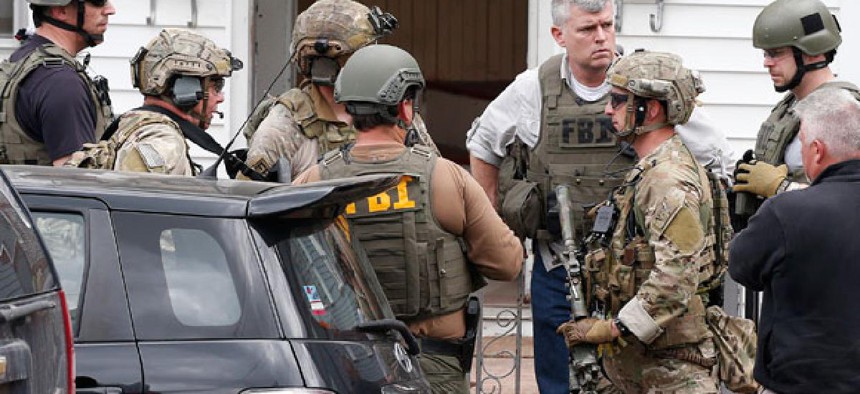
Michael Dwyer/AP
All day, cable news networks streamed live details from in Watertown, Mass., where police have locked down the area as it continues its door-to-door manhunt for the Boston Marathon bombing suspect still on the run. The FBI has a massive job to do. It must defuse the tense situation and free residents who are hiding in their homes; gather forensic evidence and witness statements; determine if there’s an international connection; and ideally bring the suspect alive to an American courtroom.
First, some background: Hours after the FBI released to the public images of the suspects who may be responsible for the deaths of three people and injuries of 170 others at the Boston Marathon finish line, the two men allegedly on Thursday night tried to rob a convenience store near the MIT campus. They also carjacked a car, from which they lobbed explosives at police in a shout-out into Watertown. Amid the violence, one suspect, identified as Tamerlan Tsarnaev, 26, died. His younger brother, the second suspect Dzhokhar Tsarnaev, 19, escaped.
Their motivation remains unclear. “You’d expect these guys to get out of town, have some money, have a plan,” said Jeff Lanza, retired FBI special agent. Since they were caught robbing a 7-Eleven store with no apparent plan to flee Boston, the bombings may not be related to some larger plot or network, Lanza said. “A larger plot would have been a flat-out suicide bomb, or [the larger organization] would have tried to get those people out after the attack. There’s clearly no effort to do that.” Still, news reports claim Tamerlan’s YouTube channel contains lectures from the radical Australian Muslim preacher Sheikh Feiz Mohammed and videos in Russian from preacher Abdel al-Hamid al-Juhani, who Fox News claims was influential with radical jihadists in Chechnya and the Russian Caucuses.
With many open questions, the FBI was working to piece together this puzzle. How are they going to do it?National Journal looks at the various stages of the ongoing investigation.
IDENTIFYING THE SUSPECTS
After Monday’s deadly bombings, agents culled through images and videos from the jam-packed Boston Marathon until they found images of suspect No.1 appearing to drop a package at one of the bombing sites. The FBI then likely performed “link analysis,” Lanza said, to determine if he had a co-conspirator, delving through the frames to see if there was another person—a process that eventually led them to the second suspect who was close behind. Before those images were released publicly, the FBI likely ran through their databases to determine if they had any leads to identify them on their own. Without such information, the FBI released the relatively clear photos to the masses, where people like Eric Mercado, who went to high school with suspect No. 2 Dzhokhar, was able to recognize his floppy hair and backwards hat and “had an idea it was him.”
GATHERING EVIDENCE
There’s a good chance that the suspects' home was booby-trapped. Bomb squads would need to scope out locations before agents could enter, likely why Massachusetts state police announced a “controlled explosion” on Norfolk Street in Cambridge, likely where the brothers had been living together. Once they have access, agents will begin a detailed investigation into the suspects' backgrounds. They will analyze every communication—from computers to e-mail to Word documents and cell phones—and talk to roommates, neighbors and family members. They will glean information from travel records and banking statements and their social media platforms. This is important for the development of an eventual prosecution, but also to find people to encourage the suspect to surrender. “If the suspect is barricaded in a house, it’s appropriate to contact the family to see if there’s a way to reason with him,” said Jeff Horblit, chief of investigative firm Northeast Intelligence Group, who is also a former FBI agent and New York prosecutor. Agents will build a web of everyone the suspects interacted with; then, they will determine which people were completely innocent, which may be witnesses and which were potential accomplices.
SCOURING THE CRIME SCENE
Agents are collecting clues from Boston’s various crime scenes, including the lid from the pressure cooker that was used as a bomb, which will almost certainly have fingerprints, said Frances Townsend, former Homeland Security Adviser to George W. Bush. “People don’t appreciate the painstaking process—because they don’t see it—of putting together tiny, tiny bits of information so they can step back and see the picture it builds,” Townsend said. “We still have this very active manhunt but as the story unfolds we’re learning more and more about these suspects.”
There are also other crimes scenes now, including the vehicle of the MIT campus police officer who was found inside with multiple gunshot wounds on Thursday night. The Mercedes owner who was the carjacking victim was with the suspects for roughly a half hour before he was released uninjured-- and according to news reports, the suspects told him they were behind the Boston blasts. “If that’s the case that person is now an incredibly important eyewitness… That’s an admission by the suspects; that’s admissible in a criminal trial," Horblit said.
DETERMINING AN OVERSEAS CONNECTION
The evidence will lead the FBI to determine whether there’s a connection to a group or individual overseas. The brothers are from a Russian region near Chechnya, but they have been in the United States for about a decade. Dzhokhar attended Cambridge Rindge and Latin School in Cambridge, and may have attended the University of Massachusetts (Dartmouth), which says it is in the process of a controlled evacuation “in response to information that the person being sought in connection with the Boston Marathon bombing is a registered student.”
With all this time in the United States, Horblit said, “it’s premature to conclude [their national origin] has any relevance." While the possibility of a full investigation overseas is likely on hold, the agency does, however, most likely want to speak with parents and relatives of the suspects. While some are local -- the suspects’ uncle in Maryland apologized to their victims, called them "losers" but proclaimed the idea that Islam would play a part was "fraud"-- some are overseas. The suspects’ father told the Associated Press from the southern Russian republic of Dagestan they were “set up.”
Face-to-face meetings would be preferable, experts said. While the FBI is capable of sending agents from the U.S., it also has officers in most countries throughout the world stationed at American embassies who could likely conduct these interviews. However, Townsend said, “if it requires an interview with an agent knowledgeable about the details of the investigation, they will put an agent on the plane to do that." More aggressive legal action, like a search, however, cannot be conducted without a request to the country itself-- and would likely be carried out by the host nation's law enforcement. “An agent may be present when that happens for the chain of evidence."
CAPTURING AND QUESTIONING THE SUSPECT
The most accurate sense of the brothers’ motivations will likely come from Dzhokhar himself when he’s taken into custody. “There is nothing these authorities want more than to take this young man alive,” Horblit said. “From an investigative standpoint, personal standpoint, moral standpoint.” But the suspect has a say in this. If he decides to shoot at officers, he is more likely to be killed. Even if the suspect is killed before he can be captured and brought to trial, Townsend said, “there’s an awful lot of forensic data [to create a case."
"They’ll put this together with or without him," she added.
NEXT STORY: Why Free Museums Are Bad for Everyone







